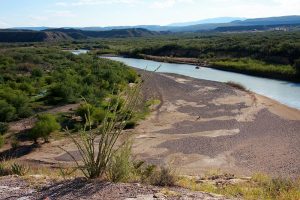On Monday the Supreme Court heard arguments in two interstate water allocation disputes, Florida v. Georgia and Texas v. New Mexico and Colorado. The Court has also accepted a third such case, Mississippi v. Tennessee, and assigned it to a special master. The cases will force the Court to examine the  balance between economic development and environmental protection, the federal role in state water disputes, and whether groundwater and surface water allocation should be governed by the same decisional rules.
balance between economic development and environmental protection, the federal role in state water disputes, and whether groundwater and surface water allocation should be governed by the same decisional rules.
The trio of pending cases belies the Court’s expressed preference for such disputes to be resolved by interstate compacts entered into pursuant to the Compact Clause (Article I, Section 10, Clause 3). It has previously commented that it approaches interstate water disputes with caution given the “complicated and delicate questions” involved, and has advised “expert administration [via a compact] rather than judicial imposition of a hard and fast rule.”[1] Nevertheless, in these cases at least, an old adage often attributed to Mark Twain trumped the Court’s advice: “whiskey is for drinking, and water is for fighting over.”
Three primary mechanisms exist to resolve water disputes between states. First, as explained above, states may negotiate agreements to be approved by Congress. At least twenty United States rivers are currently subject to interstate compacts. Second, Congress may apportion interstate waters pursuant to its Commerce Clause powers, but rarely exercises its authority due to the complex political calculations involved. Third, the Supreme Court has original jurisdiction over water disputes between states pursuant to Clauses 1 and 2 in Article III, Section 2. Such disputes may result from the absence of a compact or to resolve a dispute over a compact.
In the cases it has resolved, the Court developed the doctrine of “equitable apportionment,” a broad-based methodology to resolve water disputes involving “consideration of many factors.”[1] These may include physical and climatic conditions, alternative source availability, the relative costs and benefits of existing and proposed uses, and the laws of the party states, among other things.[2] The Court’s stated goal is, put simply, a “just and equitable” allocation.[3] In the modern era, the Court typically appoints a special master to conduct a “trial” and submit a report with a recommended outcome and findings of fact that the Court, of course, may accept or reject.
In the first case, Florida has blamed Georgia’s expanding water use in domestic, agricultural, and industrial contexts for reduced flows across the border that caused what it calls an ecological catastrophe in Florida’s Apalachicola Bay region. The case is complicated by a complex system of dams, operated by the United States via the Army Corps of Engineers, that control flow across the border between the two states. Despite this major role, the United States has been reluctant to become involved in the case; indeed, despite finding that “Florida points to real harm and, at the very least likely misuse of resources by Georgia,” the special master denied Florida’s request for a consumptive cap largely because he believed he could not bind the Army Corps to release a particular amount of water through the dam system. During Monday’s arguments, the justices appeared troubled that the master’s report ran counter to “common sense” position that a consumptive cap would necessarily mean more water flowing across the border to Georgia. Justice Kagan, however, questioned whether Florida had presented enough evidence to show how much extra water it would receive, and whether the corresponding ecological benefits would outweigh the potential harm to Georgia. Several justices also questioned the government’s absence from the case, with Justice Breyer calling it “a mystery.”
While the government has stayed on the sidelines in Florida v. Georgia, it has actively sought to become a party in a less heralded case, Texas v. Colorado and New Mexico. That issue was the crux of Monday’s argument in the context of the larger conflict surrounding a 1938 compact that governs water apportionment in the Rio Grande basin. Texas has argued that New Mexico is illegally diverting water in contravention of the compact before it crosses the border between the two states. The federal government has attempted to intervene to argue that whatever decree the Court issues will account for the United States’ obligations under a 1906 water sharing treaty with Mexico. At Monday’s argument, some of the justices, including Justice Gorsuch, implied that the federal government’s treaty obligations appear to be a “significant federal interest” justifying its intervention, but others showed concern that allowing intervention could improperly create a future right for the federal government to sue states it believes are violating water compacts.
Mississippi v. Tennessee may turn out to be the most novel case of the trio because it is the first interstate water dispute centering exclusively on groundwater. Mississippi has alleged that Tennessee is illegally pumping billions of gallons of groundwater naturally stored within Mississippi’s borders, and seeks damages and injunctive relief. That case is currently proceeding before a special master assigned by the Court.
Whatever the outcomes, the Court’s decisions in these three cases will materially advance its water law jurisprudence.
[1] Colorado v. New Mexico, 459 U.S. 176, 183 (1982).
[2] Id.
[3] Id.
[1] Colorado v. Kansas, 320 U.S. 383, 392 (1943).
